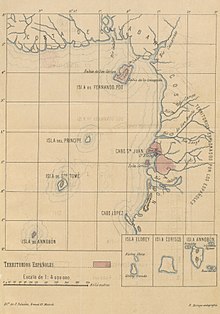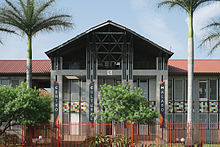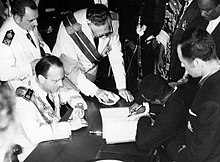History of Equatorial Guinea
[1] From 1827 to 1843, the United Kingdom had a base on Bioko to suppress the transatlantic slave trade,[3] which was then moved to Sierra Leone upon agreement with Spain in 1843.
The Treaty of Paris in 1900 left Spain with the continental enclave of Rio Muni, a mere 26,000 km2 out of the 300,000 stretching east to the Ubangi River, which the Spaniards had claimed.
Although a few of the Fernandinos were Catholic and Spanish-speaking, about nine-tenths of them were Protestant and English-speaking on the eve of the First World War, and pidgin English was the lingua franca of the island.
The indigenous Bubi population of Bioko, pushed into the interior of the island and decimated by alcoholic addiction, venereal disease, smallpox and sleeping sickness, refused to work on plantations.
Catholic penetration was furthered by two small insurrections protesting the conscription of forced labour for the plantations, in 1898 and 1910, which led to the Bubi being disarmed in 1917 and left them dependent on the missionaries.
[5] With the indigenous Bubi population decimated by disease and forced labour, the island's economy came to depend on imported agricultural contract workers.
The economy was based on large cacao and coffee plantations and logging concessions, and the workforce was mostly made up of immigrant contract labourers from Liberia, Nigeria, and Cameroon.
Moreover, the timber companies needed growing amounts of labour, and the spread of coffee cultivation offered an alternative means of paying taxes.
The French only briefly permitted recruitment in Cameroon, and the main source of labour came to be Igbo smuggled in canoes from Calabar and Oron, Nigeria.
The persisting labour shortage in the cacao, coffee and logging industries was only overcome by the mushrooming illegal canoe-based smuggling of Igbo and Ibibio workers from the Eastern Provinces of Nigeria.
The post-war political history of the colony can be divided into three fairly distinct phases: The first of these phases consisted of little more than a continuation of previous policies; these closely resembled the policies of Portugal and France, notably in dividing the population into a vast majority governed as 'natives' or non-citizens, and a very small minority (together with whites) admitted to civic status as emancipados, assimilation to the metropolitan culture being the only permissible means of advancement.
Nationalism began to emerge during this "provincial" phase, chiefly among small groups who had taken refuge from General Franco's dictatorship in Cameroon and Gabon.
In the presence of a UN observer team, a referendum was held on August 11, 1968, and 63% of the electorate voted in favour of the constitution, which provided for a government with a General Assembly and a Supreme Court with judges appointed by the president.
[citation needed] In September 1968, Francisco Macías Nguema was elected first president of Equatorial Guinea, and independence was granted in October.
[14] At independence, Equatorial Guinea had one of the highest per capita incomes in Africa, although it was also very unevenly distributed as most of the money was in the hands of colonial and elite planters.
[15] In its final years of rule the Spanish colonial government achieved a relatively high literacy rate and developed a good network of health care facilities.
The Macias regime was characterized by human rights abuses, totalitarianism[16][17] and the abandonment of all government functions except internal security, which was accomplished by terror; this led to the death or exile of up to one-third of the country's population.
The new ruler faced the challenge of restoring order in a country that was in shambles—by the end of Macias Nguema's dictatorship, the state coffers were empty and the population had been reduced to only one-third of what it was at independence.
[20][21] According to a March 2004 BBC profile,[22] politics within the country are dominated by tensions between Obiang's son, Teodorin, and other close relatives with powerful positions in the security forces.
[28] In November 2022 Teodoro Obiang was re-elected in 2022 Equatorial Guinean general election with 99.7% of the vote amidst accusations of fraud by the opposition.
[29][30] In 2024 it was published that mercenaries from the Wagner Group (now called “Africa Corps”) had entered in Equatorial Guinea at the request of Teodoro Obiang.










